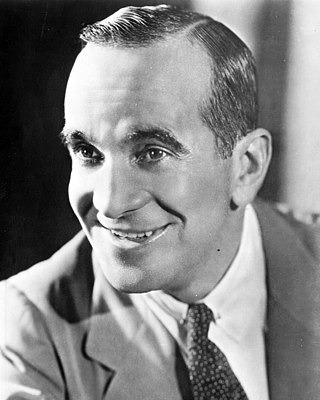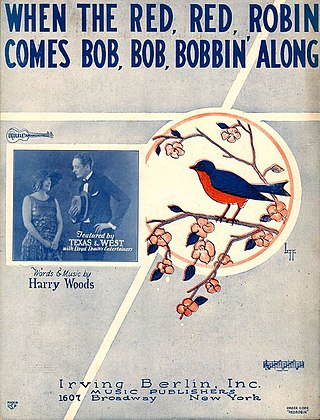
The Jazz Singer is a 1927 American part-talkie musical drama film directed by Alan Crosland and produced by Warner Bros. Pictures. It is the first feature-length motion picture with both synchronized recorded music and lip-synchronous singing and speech. Its release heralded the commercial ascendance of sound films and effectively marked the end of the silent film era with the Vitaphone sound-on-disc system, featuring six songs performed by Al Jolson. Based on the 1925 play of the same title by Samson Raphaelson, the plot was adapted from his short story "The Day of Atonement".

A sound film is a motion picture with synchronized sound, or sound technologically coupled to image, as opposed to a silent film. The first known public exhibition of projected sound films took place in Paris in 1900, but decades passed before sound motion pictures became commercially practical. Reliable synchronization was difficult to achieve with the early sound-on-disc systems, and amplification and recording quality were also inadequate. Innovations in sound-on-film led to the first commercial screening of short motion pictures using the technology, which took place in 1923. The sound film was also played with organs or pianos in the actual movie to represent sound.

The Jolson Story is a 1946 American biographical musical film, a fictionalized account of the life of singer Al Jolson. It stars Larry Parks as Jolson, Evelyn Keyes as Julie Benson, William Demarest as his manager, Ludwig Donath and Tamara Shayne as his parents, and Scotty Beckett as the young Jolson. Many of the film's episodes are based on fact but the story is simplified, with some people disguised or combined into single characters.

Vitaphone is a sound film system used for feature films and nearly 1,000 short subjects made by Warner Bros. and its sister studio First National from 1926 to 1931. Vitaphone is the last major analog sound-on-disc system and the only one that was widely used and commercially successful. The soundtrack is not printed on the film, but issued separately on phonograph records. The discs, recorded at 33+1⁄3 rpm and typically 16 inches (41 cm) in diameter, are played on a turntable physically coupled to the projector motor while the film is projected. Its frequency response is 4300 Hz. Many early talkies, such as The Jazz Singer (1927), used the Vitaphone system. The name "Vitaphone" derived from the Latin and Greek words, respectively, for "living" and "sound".

Frederick Alan Crosland was an American stage actor and film director. He is noted for having directed the first feature film using spoken dialogue, The Jazz Singer (1927).

"Blue Skies" is a popular song, written by Irving Berlin in 1926.

The Singing Fool is a 1928 American sound part-talkie musical drama motion picture directed by Lloyd Bacon which was released by Warner Bros. In addition to sequences with audible dialogue or talking sequences, the film features a synchronized musical score and sound effects along with English intertitles. The soundtrack was recorded using the Vitaphone sound-on-disc system. The film stars Al Jolson and is a follow-up to his previous film, The Jazz Singer. It is credited with helping to cement the popularity of American films of both sound and the musical genre.

I Love to Singa is a 1936 Warner Bros. Merrie Melodies animated cartoon directed by Tex Avery. The short was released on July 18, 1936.
Phonofilm is an optical sound-on-film system developed by inventors Lee de Forest and Theodore Case in the early 1920s.
George Robert Groves was a film sound pioneer who played a significant role in developing the technology that brought sound to the silent screen. He is also credited as being Hollywood's first ‘sound man’; he was the recording engineer on the seminal Al Jolson picture, The Jazz Singer (1927), as well as many other early talkies. In a career with Warner Brothers that spanned 46 years, he rose to become their Director of Sound and won two Academy Awards out of eight nominations in total.
Photo-Kinema was a sound-on-disc system for motion pictures invented by Orlando Kellum.

Al Jolson was an American singer, actor, and vaudevillian.
"Chlo-e " (1927) is a show tune with music by Charles N. Daniels, writing under the pseudonym of "Neil Morét," and lyrics by Gus Kahn. It is now regarded as a jazz standard.

The Brox Sisters were an American trio of singing sisters, enjoying their greatest popularity in the 1920s and early 1930s.

"When the Red, Red Robin " is a popular song written, both words and music, by Harry Woods in 1926. The song became the signature song for singer and actress Lillian Roth, who performed it often during the height of her musical career from the late 1920s to the late 1930s.

Sailor Izzy Murphy is a 1927 synchronized sound comedy-drama film released from Warner Bros. Pictures starring George Jessel, Audrey Ferris, Warner Oland and John Milijan. While the film has no audible dialog, it was released with a synchronized musical score with sound effects using the Vitaphone sound-on-disc process. The film was a follow-up to a previous film starring Jessel titled Private Izzy Murphy. The premiere was set for October 8, 1927, at Warners' Theater, two days after the premiere of The Jazz Singer, the first talking film (part-talkie) starring Al Jolson.
Vitaphone Varieties is a series title used for all of Warner Bros.', earliest short film "talkies" of the 1920s, initially made using the Vitaphone sound on disc process before a switch to the sound-on-film format early in the 1930s. These were the first major film studio-backed sound films, initially showcased with the 1926 synchronized scored features Don Juan and The Better 'Ole. Although independent producers like Lee de Forest's Phonofilm were successfully making sound film shorts as early as 1922, they were very limited in their distribution and their audio was generally not as loud and clear in theaters as Vitaphone's. The success of the early Vitaphone shorts, initially filmed only in New York, helped launch the sound revolution in Hollywood.

Lucky Boy is a 1929 American sound part-talkie musical comedy-drama film directed by Norman Taurog and Charles C. Wilson and starring George Jessel. In addition to sequences with audible dialogue or talking sequences, the film features a synchronized musical score, singing and sound effects along with English intertitles. The sound was recorded using the Tiffany-Tone system using RCA Photophone equipment. The film's plot bore strong similarities to that of the hit 1927 film The Jazz Singer, which had originally been intended to star Jessel before Al Jolson took over the role.

The Better 'Ole is a 1926 American synchronized sound World War I comedy drama film. Released by Warner Bros. Pictures, Inc., this film is the second full-length film to utilize the Vitaphone sound-on-disc process, two months after the first Vitaphone feature Don Juan; with no audible dialogue, the film does have a synchronized musical score and sound effects. This film was also the second onscreen adaptation of the 1917 musical The Better 'Ole by Bruce Bairnsfather and Arthur Elliot. Charlie Chaplin's eldest brother Sydney Chaplin played the main lead as Old Bill in perhaps his best-known film today. This film is also believed by many to have the first spoken word of dialog, "coffee", although there are those who disagree. At one point during the film, Harold Goodwin's character whispers a word to Sydney Chaplin which is also faintly heard. This was discovered by the UCLA's Robert Gitt, during the restoration of the sound discs for the film. The line was recorded in perfect sync, apparently during the orchestra recording sessions rather than live on set, therefore making it the earliest known use of dubbing in a motion picture.
The Jazz Singer is a play written by Samson Raphaelson, based on his short story "The Day of Atonement". Producers Albert Lewis and Max Gordon staged it on Broadway, where it debuted at the Fulton Theatre in 1925. A highly influential movie adaptation was released in 1927.














